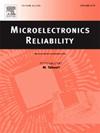Single-particle irradiation effect and anti-irradiation optimization of a heterogeneous dielectric vertical TFET with dual material gate
IF 1.9
4区 工程技术
Q3 ENGINEERING, ELECTRICAL & ELECTRONIC
引用次数: 0
Abstract
In this paper, the single-particle irradiation effect of a dual material gate heterogeneous dielectric vertical TFET (DMG-HD-VTFET) is investigated. During the irradiation, single-particle having a certain energy value generates electron-hole pairs along the incident path, which results in transient current that can disrupt the device's logic state when the quantity of these pairs becomes sufficiently large. In simulation of single-particle irradiation effect and anti-irradiation optimization, the energy carried by single-particle is represented by the linear energy transfer (LET) value. The typical value of LET is 10 MeV·cm2/mg, which is equivalent to 0.25 pC/μm along incident path. In our simulation, we first investigate the influence of single-particle with different LET energy, then the influence of incident angle variation on single-particle effect is simulated. Further, the influence of incident completion time, incident position and drain bias voltage on single-particle effect is explored. Based on these findings, anti-irradiation optimization for DMG-HD-VTFET is performed, where the dielectric and length of tunneling gate is compromised to enhance the reliability.

双材料栅极非均质介质垂直TFET的单粒子辐照效应及抗辐照优化
本文研究了双材料栅极非均质介质垂直场效应晶体管(DMG-HD-VTFET)的单粒子辐照效应。在辐照过程中,具有一定能量值的单粒子沿入射路径产生电子-空穴对,产生瞬态电流,当电子-空穴对数量足够大时,会破坏器件的逻辑状态。在单粒子辐照效应模拟和反辐照优化中,单粒子携带的能量用线性能量传递(LET)值表示。LET的典型值为10 MeV·cm2/mg,相当于0.25 pC/μm。在我们的模拟中,我们首先研究了不同LET能量的单粒子的影响,然后模拟了入射角变化对单粒子效应的影响。进一步探讨了入射完成时间、入射位置和漏极偏置电压对单粒子效应的影响。在此基础上,对DMG-HD-VTFET进行了抗辐照优化,通过降低介电介质和隧道栅长度来提高可靠性。
本文章由计算机程序翻译,如有差异,请以英文原文为准。
求助全文
约1分钟内获得全文
求助全文
来源期刊

Microelectronics Reliability
工程技术-工程:电子与电气
CiteScore
3.30
自引率
12.50%
发文量
342
审稿时长
68 days
期刊介绍:
Microelectronics Reliability, is dedicated to disseminating the latest research results and related information on the reliability of microelectronic devices, circuits and systems, from materials, process and manufacturing, to design, testing and operation. The coverage of the journal includes the following topics: measurement, understanding and analysis; evaluation and prediction; modelling and simulation; methodologies and mitigation. Papers which combine reliability with other important areas of microelectronics engineering, such as design, fabrication, integration, testing, and field operation will also be welcome, and practical papers reporting case studies in the field and specific application domains are particularly encouraged.
Most accepted papers will be published as Research Papers, describing significant advances and completed work. Papers reviewing important developing topics of general interest may be accepted for publication as Review Papers. Urgent communications of a more preliminary nature and short reports on completed practical work of current interest may be considered for publication as Research Notes. All contributions are subject to peer review by leading experts in the field.
 求助内容:
求助内容: 应助结果提醒方式:
应助结果提醒方式:


